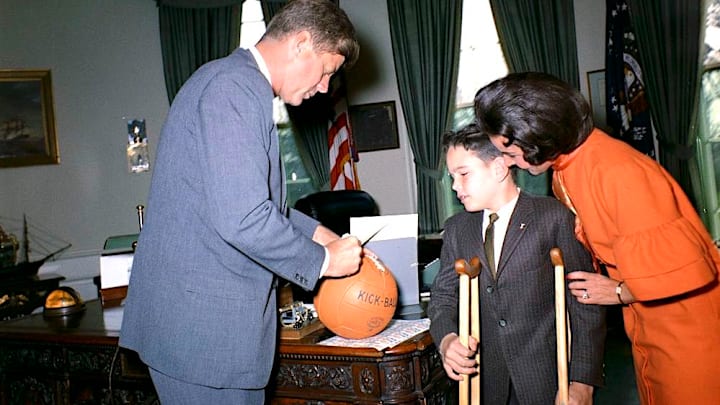The phrase poster child is deeply ingrained in the American lexicon, used to describe exemplars in everything from international politics to failed films to endangered plants, especially in academic papers. It’s often applied negatively for how not to do something. But the origins of the term are actually much more literal.
While the exact phrase didn’t enter the language until the 1930s, using children as a means to raise funds for hospitals goes way back. According to Paul Longmore’s essay “Heaven’s Special Children: The Making of Poster Children,” English artist William Hogarth painted an innocent child on a hospital’s coat of arms to invite patrons to donate around 1737. “Poster children were, by design, the most visible symbols of fundraising,” Longmore notes.
The National Society for Crippled Children, founded in 1919 to increase visibility for children with disabilities, sold “Easter seals” as a fundraiser in the 1930s. These adhesive stamps, designed by cartoonist J.H. Donahey, featured drawings of kids with crutches and the words “Help Crippled Children.” People could purchase seals for a penny apiece and apply them to letters to show their support of the organization. The seal campaigns were so successful that the organization renamed itself the National Easter Seal Society, now shortened to Easterseals. (Many decades later, on the strength of their fundraising, the National Easter Seal Society successfully lobbied for the passage of the Americans with Disabilities Act in 1990.)

But the society wasn’t the only child health organization to use its clients as fundraisers. The Georgia Warm Springs Foundation, established in 1927 by future president Franklin D. Roosevelt to treat people with polio, hired famed illustrator Howard Chandler Christy to design a poster featuring a child in a wheelchair.
Roosevelt expanded the programs started by the Warm Springs Foundation by establishing the National Foundation for Infantile Paralysis, known today as the March of Dimes, in 1938. Everyday citizens were encouraged to mail in donations as small as 10 cents to help find a cure for polio. The U.S. regularly battled seasonal outbreaks of the intestinal viral infection, which spreads through contaminated water and shared objects. It was particularly devastating to children—they often experienced the effects of post-polio syndrome, including paralysis. The virus's easy transmission forced swimming pools and community centers to shutter in summer.
While earlier campaigns featured illustrations of children, the first poster featuring a photograph of a real child made its appearance in 1947. Donald Eugene Anderson was a 6-year-old living with polio in Oregon in 1946 when the March of Dimes started its search for a child to represent the organization in fundraising advertisements. The Portland-based Shriners Hospital recommended Anderson, who had been a patient there before being discharged.

Two photos were taken to be used in the campaign, which would show everyday Americans what life was like for children with the disease. The first had Anderson leaning against a hospital bed with his shoulder and arm in a brace. The second portrayed his recovery, with Anderson strolling confidently forward without assistance. He went on a publicity tour for the campaign and met many famous people over the years, including Yankees legend Joe DiMaggio. Anderson also laid a wreath at the grave of FDR.
By 1955, Jonas Salk had developed the polio vaccine and cases among children in the United States had begun to plummet. Three years later, the March of Dimes shifted its attention to preventing birth defects and continued to feature a succession of poster children.
“I felt as though I had been changed into a new and exciting person,” Emily Rapp Black, a March of Dimes fundraiser in 1980, writes in her memoir Poster Child. “I felt famous; I felt singled out and special … I spoke to crowds both large and small about how normal my life was and how happy I was—all in an effort to raise awareness and money for an organization designed to fund research that would prevent congenital birth defects similar to my own.”
After his 15 minutes of fame, Anderson spent decades working for the U.S. Postal Service in Seattle. He married, had children, and eventually had grandchildren. He passed away in 2014 at age 73, living well past the life expectancy of a child with polio.
Other organizations saw the success of the March of Dimes’s model and launched poster child campaigns. One of the Muscular Dystrophy Association’s National Goodwill Ambassadors [PDF] in the early 2000s was 11-year-old Mattie Stepanek, who went on to become a best-selling poet and peace activist. Today, St. Jude Children’s Research Hospital and Shriner’s Hospital are two organizations that prominently feature their child patients in fundraising commercials, including Alec Cabacungan, who has appeared in Shriners ads since 2015.
Have you got a Big Question you’d like us to answer? If so, let us know by emailing us atbigquestions@mentalfloss.com.
